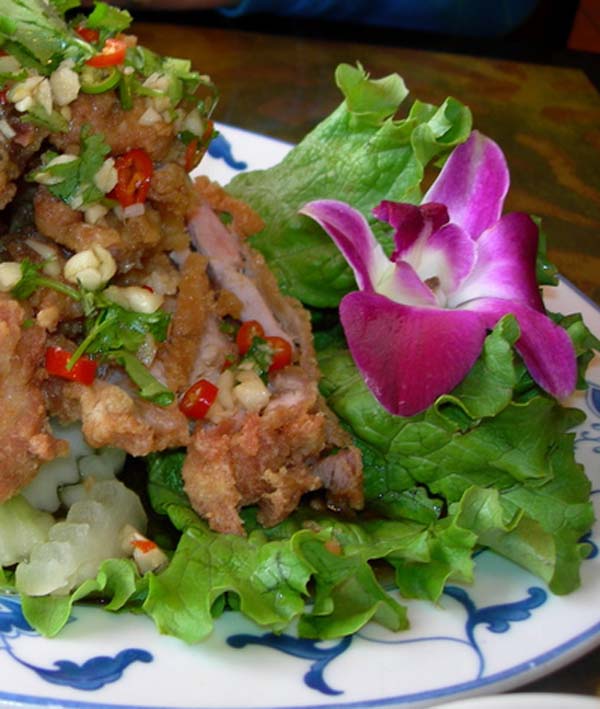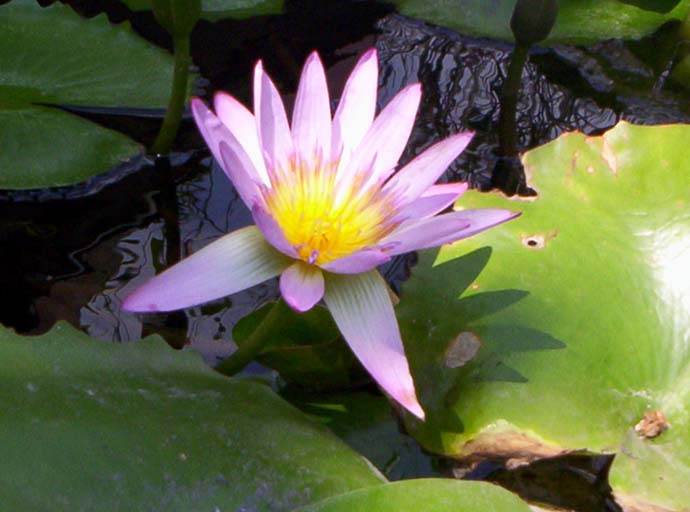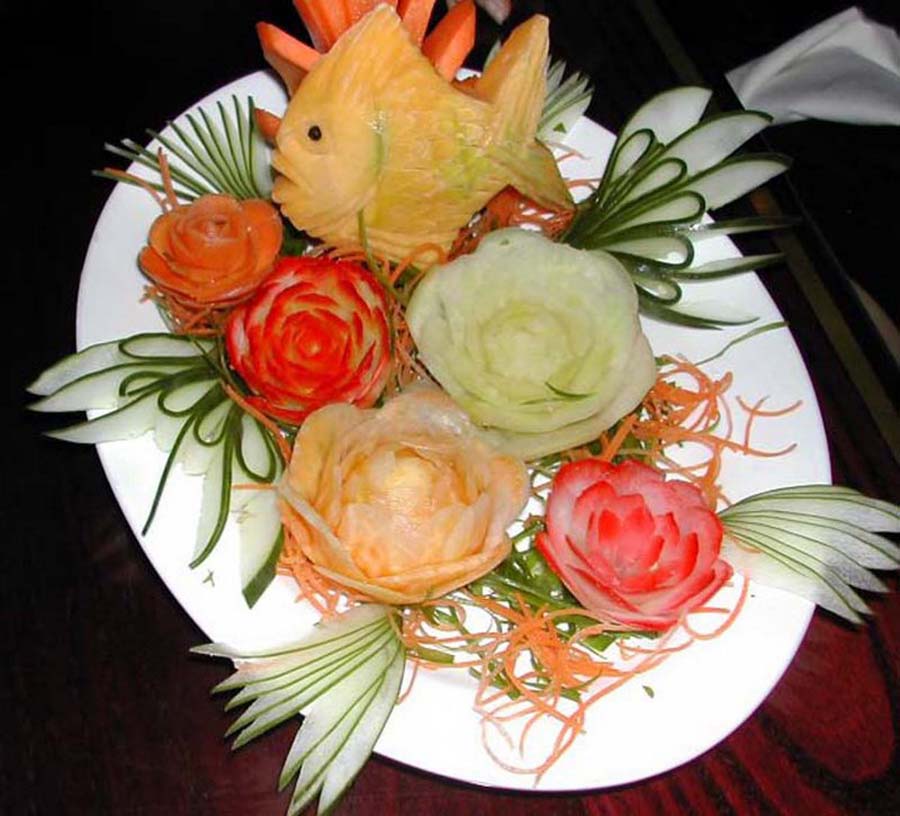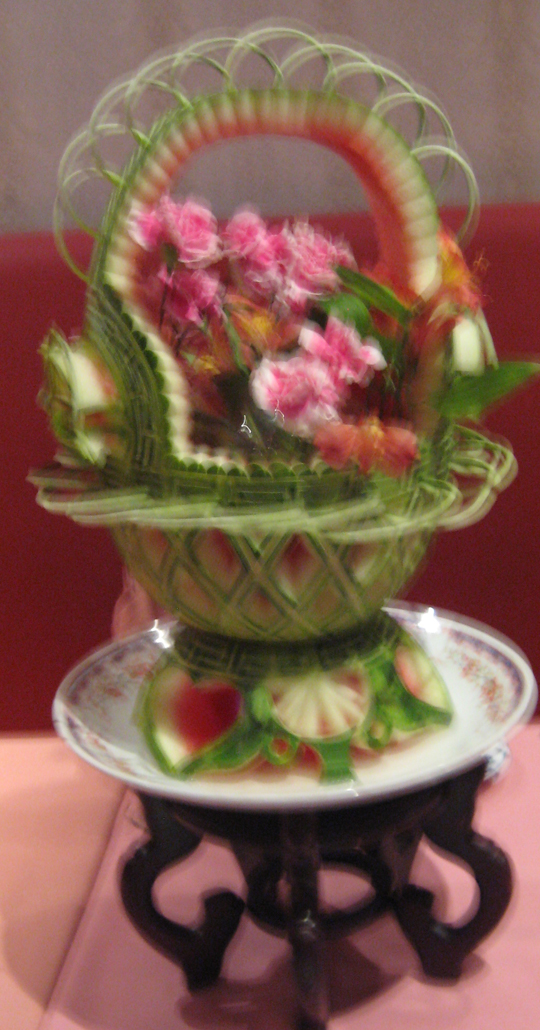
| What is Flavor and Fortune? |
| How do I subscribe? |
| How do I get past issues? |
| How do I advertise? |
| How do I contact the editor? |
Read 13088392 times
Connect me to:
| Home |
| Articles |
| Book reviews |
| Letters to the Editor |
| Newmans News and Notes |
| Recipes |
| Restaurant reviews |
| Article Index (all years, slow) |
| List of Article Years |
| Article Index (2025) |
| Article Index (last 2 years) |
| Things others say |
| Related Links |
| Log In... |
| Authors |
| Categories & Topics |
Flowers: A Culinary Romance--Part I
| by Teresa M. Chen |
Unusual Ingredients
Summer Volume: 2011 Issue: 18(2) page(s): 5 - 7
 Imagine a world without flowers; it would mimic a perpetual grey sky, no sunshine, and no rainbows. Butterflies and bees would have nothing to live for, and our senses would be deprived of color, form, fragrance, and touch. Flowers, in essence, nurture our spirit, especially at times of sorrow and joy.
Imagine a world without flowers; it would mimic a perpetual grey sky, no sunshine, and no rainbows. Butterflies and bees would have nothing to live for, and our senses would be deprived of color, form, fragrance, and touch. Flowers, in essence, nurture our spirit, especially at times of sorrow and joy.
The love for flowers is universal, though different cultures favor different ones. They bestow upon them virtues, magical power, and the status as national or state flowers. In the Western world, roses are associated with love. The Madonna lily earns its place as a symbol of purity. It is widely cultivated in monasteries and convents and featured in religious art with the Virgin Mary. Nowadays, known as the Easter lily, it is cultivated for sale at that time of year as are poinsettias for Christmas.
In the East where Confucian, Taoist, and Buddhist persuasions pervade, people make different associations with flowers. In China, the most popular flowers are the 'Four Gentlemen' known as sijunzi. They are the plum blossom or mei, the orchid or lan, the chrysanthemum or ju, and the bamboo or zhu. These represent virtues Chinese intellectuals admire. Yes, they are the same foursome found in a mahjong set, and they do correspond to the four seasons. This four gentlemen motif is repeated in poetry, painting, fabric design, architecture, and gardens. The virtues and values they stand for are deeply rooted in the Chinese psyche, items not to be taken lightly.
It may seem strange to refer to flowers as gentlemen. However, during the course of Chinese history, there were indeed gentlemen who have each immortalized a flower. They became the personification of the virtue throughout their lives. Each earned literary merit as well as romance with his flower.
Mei, variously translated as plum blossom or Japanese apricot, is a member of the rose family. Like the crocus, it blossoms in the snow and is the harbinger of spring. The virtue it stands for is hardiness or endurance. Mei was the national flower of the Republic of China founded in 1911 by Dr. Sun Yat-sen. The mei flower was made famous by an eccentric man named Lin He-Jing. He never married, proclaimed mei to be his wife, the cranes he kept, his children.
Lan, the orchid, is probably the cymbidium indigenous to the Yangzi River. Its spokesperson is Qu Yuan, a poet who likened the fragrant flowers in the marshes to himself, a loyal and virtuous minister in exile. The noble spirit in the glorious verses, Qu Yuan's legacy, lingers on like fragrance of an orchid to comfort a dejected Chinese soul. It is Qu Yuan whose death inspired the Dragon Boat Festival on the fifth day of the fifth moon.
Ju, the chrysanthemum, is the beloved flower of Tao Qian, aka Tao Yuan-Ming. At a time when Taoist influence was on the rise in China, Tao chose to retreat from government office and return to nature, leading the simple carefree life of a hermit in the countryside. Though Tao mentions willows and pines near his hut, the flower he mentions again and again in his poems is the chrysanthemum; it grew along his eastern fence. Since then, chrysanthemum has been inseparable from Tao the hermit; it is a yearning for the simple life. As the chrysanthemum blooms in autumn long after the summer flowers are gone, its attribute is the virtue of steadfastness.
While the Imperial family of Japan has long adopted the chrysanthemum as its symbol or family crest, the Japanese people chose cherry blossoms to represent their culture and nation. The fact that they burst into full glory and quickly fade into demise has inspired them to understand, appreciate, and savor fleeting moments to the fullest.
 As an Asian, I am duty-bound to introduce lian, the lotus blossom, in place of the bamboo which flowers only once in its lifetime. Very few people have seen a bamboo flower. The great lover of the lotus blossom lived in the eleventh century CE and is Zhou Dun-Yi. In his well-recited and well-cited article: For the Love of Lotus or Ai Lian Shuo in Chinese, he declares the lotus to be yet another great gentleman who 'emerged from the mud, was pure and untainted, bathed in the waves and did not affect glamour nor coyness.' In short, the lotus embodies grace and is a revered Buddhist symbol.
As an Asian, I am duty-bound to introduce lian, the lotus blossom, in place of the bamboo which flowers only once in its lifetime. Very few people have seen a bamboo flower. The great lover of the lotus blossom lived in the eleventh century CE and is Zhou Dun-Yi. In his well-recited and well-cited article: For the Love of Lotus or Ai Lian Shuo in Chinese, he declares the lotus to be yet another great gentleman who 'emerged from the mud, was pure and untainted, bathed in the waves and did not affect glamour nor coyness.' In short, the lotus embodies grace and is a revered Buddhist symbol.
While flowers feed the senses, the mind, and the spirit, some gourmets romance with flowers in food. In the western world, a summer salad of mixed greens and flowers brightens many a table. A bowl of cream of asparagus and barley soup topped with violets drives away the spring chill. When in season, squash blossoms find their way to many a Chez Panisse menu with a main entre.
The Chinese mix their tea with jasmine, chrysanthemum, hibiscus, or rose for additional aroma and flavor. It is easy to love these and all flowers for practical reasons, and to love them in food and drink.
In traditional Chinese medical terms, most edible flowers are mildly sweet and bitter in taste; slightly cold in nature, clearing heat, and cooling the liver. They are capable of resolving toxicity. Besides muo li hua cha or jasmine tea, and ju hua cha which is chrysanthemum tea, both available in tea houses serving dim sum, southern Chinese from the Pearl River Delta make soup or beverage with cereus blossoms, selfheal, chrysanthemum, honeysuckle, kapok flowers, chamomile, magnolia, and flowers of the hyacinth bean. Yes, flowers do have healing properties, according to traditional Chinese medicine beyond their sensual appeal.
The beauty of flowers is imitated by chefs in food styling and design. Pastry like the moon cake shown here can bear a floral motif. Meat and vegetable slices are often arranged in floral patterns as is napa cabbage shown on this page arranged like a peony. One sees tomatoes, radishes, and carrots made into rosettes for decoration; they are likewise illustrated here. Real flowers are also used as garnish. Popular these days are dendrobium orchids, while chrysanthemum petals make elegant garnish for an expensive bisque with crabmeat and/or scallop, and for the editor's Chrysanthemum Chicken recipe in the previous issue of Flavor and Fortune which is Volume 17(3) on pages 5 - 7. Many chefs only use organic flowers free of pesticide and/or spray.
Garnishes such as dendrobium orchids, though edible, are rather bland in taste. So are violets, nasturtiums, calendula, and chrysanthemums. Note that any dressing should be added last so as not to cover up the beauty of flowers.
 Most common among flowers one commonly eats are broccoli and cauliflower. Though only recently introduced in the Chinese culinary, their florets are now readily embraced by Chinese chefs in combination with expensive ingredients such as steak and abalone. Fresh flower stalks of garlic chives have been an all-time favorite. Dried tiger-lily buds are used in a variety of dishes in China and in other Asian cuisines. Banana blossoms And bamboo shoots are too; they both provide high dietary fiber.
Most common among flowers one commonly eats are broccoli and cauliflower. Though only recently introduced in the Chinese culinary, their florets are now readily embraced by Chinese chefs in combination with expensive ingredients such as steak and abalone. Fresh flower stalks of garlic chives have been an all-time favorite. Dried tiger-lily buds are used in a variety of dishes in China and in other Asian cuisines. Banana blossoms And bamboo shoots are too; they both provide high dietary fiber.
Below are two of my recipes, both of Cantonese origin. They feature garlic chive flower stalks and tiger lily buds. Whole garlic chives are available year-round, their tender and delicious flower spikes only harvested during a very short season before the buds are open. These recipes are followed by two others, thanks to the editor. They are seasonal and considered banquet or imperial dishes. One includes jasmine petals, the other petals from the lotus flower.
My first recipe is a vegetarian version. My father's favorite way is to cook this with sweet fresh-water shrimp. During a trip with Chef Martin Yan in 2009, which I wrote about in Flavor and Fortune's Volume 17(3) on pages 13 and 14, this gourmet dish included crunchy deep-fried silkworm cocoons. My second recipe is a classic Cantonese stew specifically from Shunde, the birth place of many famous chefs. I hope you try and enjoy them all and those that will follow in Part II of this pair of articles. You might also want to try carving flowers. The Chinese like them fresh and when carved from vegetables; some are shown near the end of this article. _____
_____
Teresa M. Chen is the author of the book titled: A Tradition of Soup: Flavors from China's Pearl River Delta, published by North Atlantic Books in 2009. She is a health educator at Pacific Complementary Medicine Center in Stockton, California.
| Garlic Chive Flower Stalks with Peanuts |
|---|
6 ounces garlic chive flower stalks, cut in two-inch sections 2 ounces Sichuan preserved turnip, thinly sliced 1/3 cup roasted peanuts, slightly crushed 1 piece seasoned and pressed tofu, thinly sliced 2 Tablespoons vegetables oil 1 Tablespoon vegetarian oyster-flavored sauce 1/4 cup water or vegetable broth Preparation: 1. Place a stir-fry pan over high heat until hot. Add the oil, swirling to coat the sides. 2. Add garlic chive spikes to cook, stirring for about one and a half minutes or until fragrant. 3. Add preserved turnip and pressed tofu, continue stirring for another minute. 4. Add oyster sauce and water and stir well for thirty seconds, then add peanuts, and serve. |
| Stewed Chicken, Tiger Lilies, and Black Woodear Fu |
|---|
1 whole chicken (about 2 and a half pounds) 1/4 cup reconstituted tiger lily buds 1/4 cup reconstituted black wood ear (Tremella fungi ) 6 dried black mushrooms (optional) 3 stalks scallion, cut pale part into one-half inch sections 3 slices fresh ginger root 2 Tablespoons soy sauce 2 Tablespoons vegetable oil 2 Tablespoons cooking wine 1 Tablespoon sugar 2 cups water Preparation: 1. Soak tiger lily buds until soft. Pinch off hard end and tie each one into a knot. 2. Soak black wood ear fungi until expanded and soft. Cut off any hard ends and slice them into bite-size pieces. Discard the soaking liquid. 3. Soak black mushroom until soft, if using. Cut off stem and slice each cap into four pieces. 4. Remove skin and fat of chicken. Cut chicken lengthwise in half. Cut off wings and separate the sections at the joints. Separate the breast from the leg sections. Chop each quarter into bite-size pieces. Rinse the chicken and pat dry. 5. Place oil in a hot wok, put ginger slices in before putting in chicken. Stir-fry until color changes, then add wine, soy sauce, sugar, two cups of liquid including the black mushroom soaking water, the tiger lily buds, black mushrooms--if using them, and the wood ear fungi. Cover and simmer for half an hour, adding the scallion toward the last five minutes of cooking. |
| Silver Ear Soup with jasmine Petals |
|---|
3 Tablespoons dried silver ear fungi 30 jasmine flowers, their petals separated 6 cups chicken stock 2 Tablespoons Chinese white wine 1/2 teaspoon salt 3 coriander leaves, slivered Preparation: 1. Soak silver ear fungi in tepid water for two hours, then rinse them several times with cold water. Remove any hard parts and discard them. 2. In a small pot, bring two cups water to the boil, remove from the stove, and immediately soak the silver ear fungi for half hour. Drain them and tear any large pieces into smaller ones, leaving none larger than a half-inch in sizes. 3. Bring chicken stock to the boil, add the drained fungi, reduce the heat, and simmer for five minutes. Add the wine and the salt, stir, then serve this into six individual soup bowls. Sprinkle each with the jasmine petals and the slivers of coriander, then serve. |
| Chicken with Lotus Blossom Petals |
|---|
1/2 pound chicken breast meat, sliced 1 egg white 2 teaspoons cornstarch 1 Tablespoon lard, chicken fat, or vegetable oil 2 Tablespoons any small white mushroom, sliced 2 Tablespoons canned bamboo shoots, sliced thin then soaked in cold water for ten minutes, and drained 2 lotus blossoms, petals removed from the flowers and each petal cut in half, tip to stem end. Rinse them pouring boiling water over them, then drain well 1 Tablespoon Chinese rice wine 1/2 teaspoon coarse salt 1 Tablespoon cornstarch mixed with same amount of cold water Preparation: 1. Mix chicken slices, egg white and two teaspoons of cornstarch, and let rest ten minutes. 2. Heat wok, add fat or oil, and stir-fry chicken breast pieces for one minute before adding sliced mushrooms and bamboo shoots, and stir-frying this for another two minutes. Turn the meat source to high, add lotus petals, rice wine, salt, and the cornstarch mixture, and stir for half minute or until the sauce is thickened. Then serve. |

Copyright © 1994-2025 by ISACC, all rights reserved
Address
3 Jefferson Ferry Drive
S. Setauket NY 11720